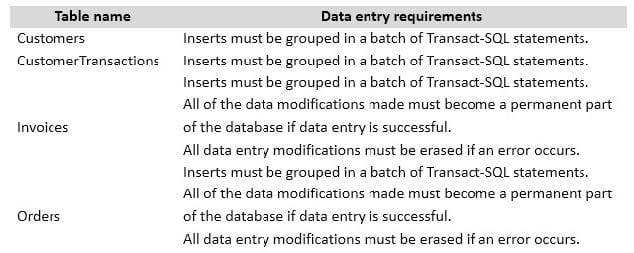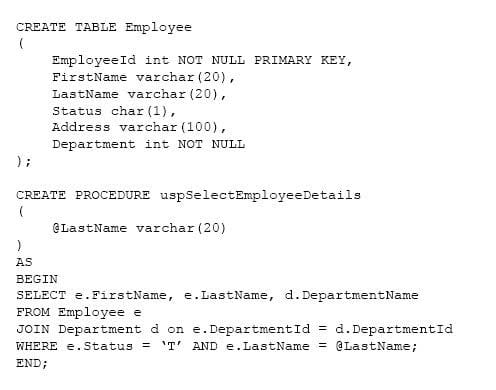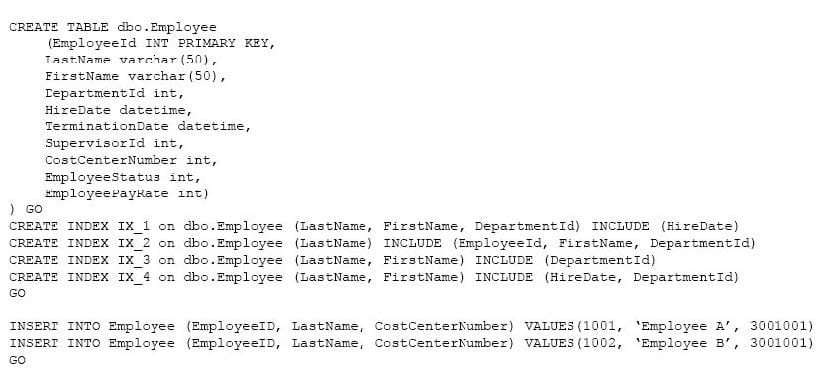Exam Details
Exam Code
:70-762Exam Name
:Developing SQL DatabasesCertification
:Microsoft CertificationsVendor
:MicrosoftTotal Questions
:182 Q&AsLast Updated
:Jan 29, 2022
Microsoft Microsoft Certifications 70-762 Questions & Answers
-
Question 41:
Note: This question is part of a series of questions that use the same answer choices. An answer choice may be correct for more than one question in the series. Each question is independent of the other questions in this series. Information and details provided in a question apply only to that question.
You are developing an application to track customer sales. You create tables to support the application. You need to create a database object that meets the following data entry requirements: What should you create?

A. extended procedure
B. CLR procedure
C. user-defined procedure
D. DML trigger
E. DDL trigger
F. scalar-valued function
G. table-valued function
-
Question 42:
You are experiencing performance issues with the database server.
You need to evaluate schema locking issues, plan cache memory pressure points, and backup I/O problems.
What should you create?
A. a System Monitor report
B. a sys.dm_tran_database_transaction dynamic management view query
C. an Extended Events session that uses Query Editor
D. an Activity Monitor session in Microsoft SQL Management Studio.
-
Question 43:
Note: This question is part of a series of questions that use the same or similar answer choices. An answer choice may be correct for more than one question in the series. Each question is independent of the other questions in this series.
Information and details provided in a question apply only to that question.
You have a database named DB1. There is no memory-optimized filegroup in the database.
You have a table and a stored procedure that were created by running the following Transact-SQL statements:

The Employee table is persisted on disk. You add 2,000 records to the Employee table.
You need to create an index that meets the following requirements:
Optimizes the performance of the stored procedure.
Covers all the columns required from the Employee table.
Uses FirstName and LastName as included columns.
Minimizes index storage size and index key size.
What should you do?
A. Create a clustered index on the table.
B. Create a nonclustered index on the table.
C. Create a nonclustered filtered index on the table.
D. Create a clustered columnstore index on the table.
E. Create a nonclustered columnstore index on the table.
F. Create a hash index on the table.
-
Question 44:
Background
You have a database named HR1 that includes a table named Employee.
You have several read-only, historical reports that contain regularly changing totals. The reports use multiple queries to estimate payroll expenses. The queries run concurrently. Users report that the payroll estimate reports do not always run.
You must monitor the database to identify issues that prevent the reports from running.
You plan to deploy the application to a database server that supports other applications. You must minimize the amount of storage that the database requires.
Employee Table
You use the following Transact-SQL statements to create, configure, and populate the Employee table:

Application
You have an application that updates the Employees table. The application calls the following stored procedures simultaneously and asynchronously:
UspA: This stored procedure updates only the EmployeeStatus column.
UspB: This stored procedure updates only the EmployeePayRate column.
The application uses views to control access to data. Views must meet the following requirements:
Allow user access to all columns in the tables that the view accesses.
Restrict updates to only the rows that the view returns.
Exhibit

You are analyzing the performance of the database environment. You discover that locks that are held for a long period of time as the reports are generated.
You need to generate the reports more quickly. The database must not use additional resources.
What should you do?
A. Update the transaction level of the report query session to READPAST.
B. Modify the report queries to use the UNION statement to combine the results of two or more queries.
C. Set the READ_COMMITTED_SNAPSHOT database option to ON.
D. Update the transaction level of the report query session to READ UNCOMMITTED.
-
Question 45:
Note: This question is part of a series of questions that present the same scenario. Each question in the series contains a unique solution that might meet the stated goals. Some questions sets might have more than one correct solution,
while others might not have a correct solution.
After you answer a question in this section, you will NOT be able to return to it. As a result, these questions will not appear in the review screen.
You have a database that is 130 GB and contains 500 million rows of data.
Granular transactions and mass batch data imports change the database frequently throughout the day. Microsoft SQL Server Reporting Services (SSRS) uses the database to generate various reports by using several filters.
You discover that some reports time out before they complete.
You need to reduce the likelihood that the reports will time out.
Solution: You partition the largest tables.
Does this meet the goal?
A. Yes
B. No
-
Question 46:
Note: This question is part of a series of questions that present the same scenario. Each question in the series contains a unique solution that might meet the stated goals. Some questions sets might have more than one correct solution,
while others might not have a correct solution.
After you answer a question in this section, you will NOT be able to return to it. As a result, these questions will not appear in the review screen.
You have a database that is 130 GB and contains 500 million rows of data.
Granular transactions and mass batch data imports change the database frequently throughout the day. Microsoft SQL Server Reporting Services (SSRS) uses the database to generate various reports by using several filters.
You discover that some reports time out before they complete.
You need to reduce the likelihood that the reports will time out.
Solution: You change the transaction log file size to expand dynamically in increments of 200 MB.
Does this meet the goal?
A. Yes
B. No
-
Question 47:
Note: This question is part of a series of questions that present the same scenario. Each question in the series contains a unique solution that might meet the stated goals. Some questions sets might have more than one correct solution,
while others might not have a correct solution.
After you answer a question in this section, you will NOT be able to return to it. As a result, these questions will not appear in the review screen.
You have a database that is 130 GB and contains 500 million rows of data.
Granular transactions and mass batch data imports change the database frequently throughout the day. Microsoft SQL Server Reporting Services (SSRS) uses the database to generate various reports by using several filters.
You discover that some reports time out before they complete.
You need to reduce the likelihood that the reports will time out.
Solution: You create a file group for the indexes and a file group for the data files. You store the files for each file group on separate disks.
Does this meet the goal?
A. Yes
B. No
-
Question 48:
Note: This question is part of a series of questions that present the same scenario. Each question in the series contains a unique solution that might meet the stated goals. Some questions sets might have more than one correct solution,
while others might not have a correct solution.
After you answer a question in this section, you will NOT be able to return to it. As a result, these questions will not appear in the review screen.
You have a 3-TB database. The database server has 64 CPU cores.
You plan to migrate the database to Microsoft Azure SQL Database.
You need to select the service tier for the Azure SQL database. The solution must meet or exceed the current processing capacity.
Solution: You select the Premium service tier.
Does this meet the goal?
A. Yes
B. No
-
Question 49:
Note: This question is part of a series of questions that present the same scenario. Each question in the series contains a unique solution that might meet the stated goals. Some questions sets might have more than one correct solution,
while others might not have a correct solution.
After you answer a question in this section, you will NOT be able to return to it. As a result, these questions will not appear in the review screen.
You have a 3-TB database. The database server has 64 CPU cores.
You plan to migrate the database to Microsoft Azure SQL Database.
You need to select the service tier for the Azure SQL database. The solution must meet or exceed the current processing capacity.
Solution: You select the Standard service tier.
Does this meet the goal?
A. Yes
B. No
-
Question 50:
Note: This question is part of a series of questions that present the same scenario. Each question in the series contains a unique solution that might meet the stated goals. Some questions sets might have more than one correct solution,
while others might not have a correct solution.
After you answer a question in this section, you will NOT be able to return to it. As a result, these questions will not appear in the review screen.
You have a 3-TB database. The database server has 64 CPU cores.
You plan to migrate the database to Microsoft Azure SQL Database.
You need to select the service tier for the Azure SQL database. The solution must meet or exceed the current processing capacity.
Solution: You select the Basic service tier.
Does this meet the goal?
A. Yes
B. No
Related Exams:
62-193
Technology Literacy for Educators70-243
Administering and Deploying System Center 2012 Configuration Manager70-355
Universal Windows Platform – App Data, Services, and Coding Patterns77-420
Excel 201377-427
Excel 2013 Expert Part One77-725
Word 2016 Core Document Creation, Collaboration and Communication77-726
Word 2016 Expert Creating Documents for Effective Communication77-727
Excel 2016 Core Data Analysis, Manipulation, and Presentation77-728
Excel 2016 Expert: Interpreting Data for Insights77-731
Outlook 2016 Core Communication, Collaboration and Email Skills
Tips on How to Prepare for the Exams
Nowadays, the certification exams become more and more important and required by more and more enterprises when applying for a job. But how to prepare for the exam effectively? How to prepare for the exam in a short time with less efforts? How to get a ideal result and how to find the most reliable resources? Here on Vcedump.com, you will find all the answers. Vcedump.com provide not only Microsoft exam questions, answers and explanations but also complete assistance on your exam preparation and certification application. If you are confused on your 70-762 exam preparations and Microsoft certification application, do not hesitate to visit our Vcedump.com to find your solutions here.


